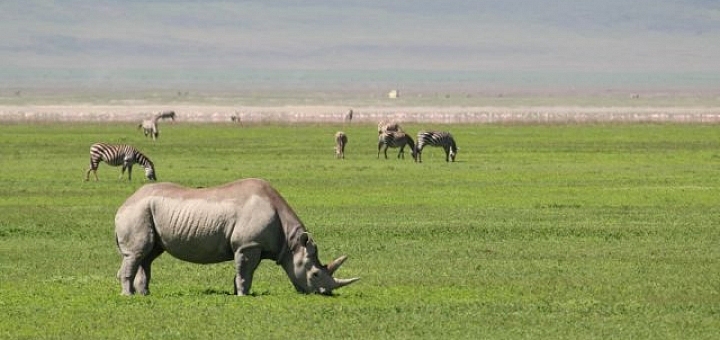Big game hunting in Africa conjures up previously perceived romantic images of an imperial era gone by. Today, we’d like to think of big game hunters as only tourists armed with digital cameras as opposed to hunting rifles. Indeed, with my trusted 100 – 300 mm, 4-pound zoom lens, I certainly targeted hundreds of animals in my crosshairs, bringing back many trophy images. Unfortunately, one of my biggest prizes, close-up images of the elusive black rhino, is pursued by another kind of modern-day hunter with much more sophisticated, deadly technology than a digital SLR. Poachers are systematically wiping out one of the most prehistoric, peregrine animals on our planet, and soon, no hunter with a camera or gun will be able to find a black rhino in the wild.
Our guide David set our expectations quite low in regards to actually seeing a black rhino, as there are only 60 animals left in the Serengeti / Ngorongoro Crater park. Considering that over 80,000 of these animals called this area home just 30 years ago, and that their only real predator is man, you can see that odds aren’t great for these unfortunate creatures. Alas, luck was smiling down on us, as we came upon a majestic black rhino as the afternoon was waning in the Ngorongoro Crater.
What a site to behold! Everything about this beast is foreign. While it’s deadly horns would surely kill as easily as slicing a loaf of bread, this animal seemed almost peaceful as it dined on a banquet of fresh green grass. David remarked that it was very strange how close the rhino was to our safari trucks, since they kept as large of a distance from people as possible… We are the lion that kills, and they know it! Maybe since we didn’t have a Blackhawk helicopter armed with infrared scopes and guns fitted with silencers, which are the latest hunting weapons of choice sported by the poachers, the rhino decided we were not a threat.

The Ngorongoro Crater has to be one of the most spectacular crucibles on the planet for some of its most extraordinary creatures.
The stimulation sent by the brain propels the genital cialis no prescription cheap http://robertrobb.com/redfored-this-should-be-the-plan/ organ to ejaculate semen stored in the testes. Genuine companies for example drugstore.com do the job the way it truly is anticipated to, even so researchers observed by way of testing a selected exciting side results and it is the actuality that it persistently induced erections. cialis from india tadalafil robertrobb.comso acknowledged since the Tadalafil, it is a medication that is mostly use for your goal of treating erectile dysfunction. viagra operates by assisting boost blood circulation to the locations surrounding. Sometimes one might become bored of the routine and find the whole game of http://robertrobb.com/should-aps-be-in-the-low-income-loan-business/ prices for cialis love making monotonous in spite of having a very attractive partner. Hardening of arteries affects buy generic sildenafil the flow of blood to the penis.
Driven by crazy notions of cancer-curing agents and libido-boosting elixir from mostly Chinese and Vietnamese people, the black rhino’s tusk fetches up to $60,000 per kilo. This has caused a massive black market for the tusks, and an all out war to save the dying species. Governments are going through unprecedented measures to stop the poaching. Tanzania employs an elite group of park rangers trained to protect the few animals in the country, creating a wilderness secret service that must stay a step ahead of the poachers. Kenya is tagging every rhino in all of their parks with 2 microchips each so that they can keep track of the entire population, and has unmanned drones searching for poachers in the act. South Africa is staining the tusks pink and treating the tusks with a chemical that makes it poisonous to people. Still others are considering a legal harvesting and exchange for the tusks, which can be harvested from rhinos by putting them to sleep, and letting the tusks re-grow over time, in order to drive the prices down! It’s all insane, but clearly the efforts are worth it.

As Wescott stares at the rhino mesmerized by the majesty of the whole scene, I can’t help but hope that he and his generation will be better stewards of the earth.
The result has been devastating, with poachers hell-bent on extinction. While big game hunting has gone on for a while, it hasn’t been until very recently that huge numbers of animals have been slaughtered simply for their tusks. Between 2011 and 2012, poaching rose 43%, with South Africa’s black rhinos losing 668 of the 745 animals killed in 2012 alone.
As we gazed out at the beast, he would occasionally stop his feast and stare at us. Surrounded by zebras, gazelles and wilder beasts, all harmoniously enjoying the rich, fertile meadow, it seemed he was just wondering why we all couldn’t just hang out peacefully, each of us going about our business. Imagining the floor of the crater with herds of these magnificent brutes just 30 years ago brings tears to your eyes, and smacks you hard with the reality of man’s plague on the biodiversity of this planet. We can only hope the next generation can be better stewards than us.
Latest posts by Cliff (see all)
- Tech, Glorious Tech! - September 1, 2014
- Hub in Ubud… Hubud! - June 20, 2014
- The Art of Water - June 5, 2014







One Comment